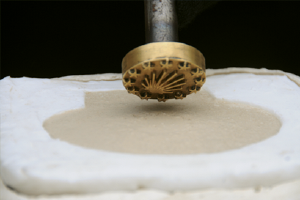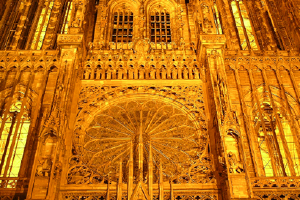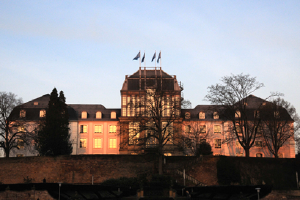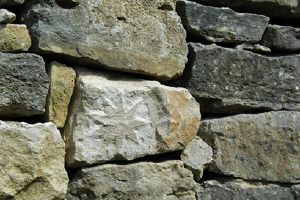Model Project Starry Path
Against this background, along these rediscovered regional routes of the medieval pilgrims of St. James, with the support of many people and institutions, are Signposts which draw attention to the special features of these partial stages in the direction of Spain to the grave of St. James in Santiago de Compostela.
These are on the one hand Path ornaments from field stones, partly with star symbols (these waymarkers can only be discovered in the core zone of the project, i.e. in the Saarpfalz district and in the Saarbrücken region). On the other hand around stone scallops, so-called scallop stoneswhich mark testimonies of the medieval building culture at the wayside and in the closer environment.
Today, more than 350 recorded positions of these gems trace the footsteps of those pilgrims who sought their paths through these multifaceted landscapes in the Middle Ages. In the present day, these waymarkers invite visitors to search for traces, occasionally off the beaten path.
The strategy resembles the essence of acupuncture and provides a viable model of how neighboring regions and communities can be understood and networked on the basis of cultural-historical anchor points with “klein gestures” in a European and equally spiritual context. More than 3000 people have so far been directly or indirectly involved in the model project.
Under the Milky Way
The term “Starry Way” is historically inspired: In the Middle Ages, the Milky Way was seen as a cosmic reference to the tomb of St. James in Santiago de Compostela. Alternative names such as “Caminus Stellarum” or “Camino de las estrellas” or “Stars’ Way” have also been known since the Middle Ages for the network of routes taken by the pilgrims of St. James toward Spain (compare also Myth of St. James’ Way).
Join us “Under the Milky Way” on the Starry Way through multifaceted cultural landscapes - guided by the waymarkers - to small and large cultural testimonies that the rediscovered European paths of the St. James pilgrims in this region have to offer us. They are part of a unique European cultural route, declared a World Heritage Site by UNESCO, and recall the medieval pilgrimage route to Santiago de Compostela. Experience a major region at one of Europe’s important seams. You will encounter both Palatine and Saarland culture as well as French (Lorraine and Alsace) culture in the project area, along the path routes. They also cross cultural landscapes that have been designated as model regions by UNESCO as biosphere reserves.

Biosphere reserves are model regions
The paths of the St. James pilgrims in the Palatinate as well as in the Saarland lead through the biosphere reserves Pfälzerwald/

Getting a stone rolling
The Saarbrücken region is one of the hubs of the rediscovered paths of the pilgrims of St. James from the direction of Speyer, Worms and Mainz via Saarbrücken to Metz. This set the ball rolling for the idea “Starry Path/
The starting signal was given in 2006. In a first project phase, the project was implemented together with the neighboring Saarpfalz district on the Saarland | North Route and Saarland | South Route of the Way of St. James pilgrims from the former Benedictine monastery of Hornbach through the Bliesgau Biosphere Reserve to Sarreguemines and Saarbrücken/
In a further phase, with the support of the St. James Society Rhineland-Palatinate-Saarland e.V. and many other committed partners, the project has successively developed into an exemplary European cultural and landscape project (cf. Imprint).

FromWegen
The possibility of integrating job-seeking, predominantly young people into this cultural landscape project in an identity-forming way forms a supporting pillar of the project “Starry Path/
For the predominantly young women and men who were looking for work or a training position, the craft and design production of these “waymarks” and their realization on site offered the opportunity to further qualify themselves via a cross-border model project and to improve their career prospects. The motto was: “FromWay…we can do it! The way is the goal and opens up new perspectives!” The goals of the project also include raising participants’ awareness of the special resources of the region - their European homeland - and awakening their commitment to an extraordinary cultural project.

Philosophy of the European model project
The world is out of balance. Unreflective growth thinking and consumerism are leading to an emptying of meaning and a creeping loss of values. Europe needs a new vision for the future.
Regional development strategies can therefore hardly survive without a value-creating and networking cultural factor. What is being sought are ideas in which sustainable forms of life - concept over life[s] art - can be developed across the “church towers” even in a large-regional context across borders. Cultural or aesthetic and ethical education provide significant support in overcoming outdated limitations and structures.
This project makes use of these aspects and wants to illustrate how a cross-border and at the same time large-regional experience space can be provided for an inspiring and creative being on the way and a value-oriented European togetherness.
The philosophy of the Starry Way is based on the encounter and exchange of cultures, drawing on the myth of the pilgrimage to the tomb of the Apostle James. This pilgrimage to a great destination represents the roots of Europe and the origin of nature-based and spiritual travel.
The pilgrimage of the Middle Ages was characterized by a cosmopolitan curiosity and constant encounters with the foreign. Their success was highly dependent on mercy, friendly encounters and cultural exchange as nourishment for the body and soul. The philosophy of the project refers to these traditional contexts. The goal is to communicate and reflect on these aspects of early travel along the regional axes of the paths of the pilgrims of St. James.
In this sense, pilgrimage on the Sternenweg stands in the present for the departure to new goals: a forward movement to leave behind traditional limitations and structures, to gather new insights for sustainable ways of life and a friendly European togetherness.

Against this background, the project “Stars’ Path/
Peace Pilgrims
Welcome to the paths along the stars in the heart of Europe!
The paths of the St. James pilgrims, who have been following a collective trail of pilgrimage to the tomb of the Apostle James across Europe for 1000 years, are among the spiritual origins of Europe in terms of cultural history. A network of paths trodden with millions of footprints spans today’s Europe and symbolically reflects the exchange and friendly encounter of cultures that a boundless journey through foreign lands and the slow approach to a \u201grand goal\u201c entails in the present.
The current discussions about the continued existence of Europe illustrate the desire for a vision of the future: a vibrant civil society that is open to the world. A Europe of tolerance, humanity, freedom, democracy, friendly encounter of cultures and peace.
Explore your soul and spread that European spirit while walking in the footsteps of the medieval pilgrims of St. James, alone or together under the stars of Europe.
New convictions create realities! Europe’s strength is its values. A better world is possible!














